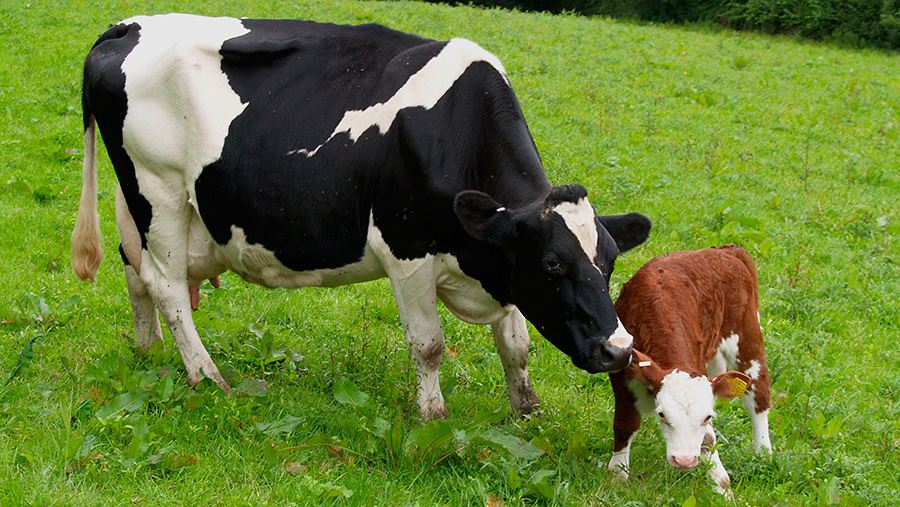Pros and cons of allowing dairy cows to nurse calves
 © FLPA/REX/Shutterstock
© FLPA/REX/Shutterstock Scandinavian systems allowing dairy cows to nurse and interact with heifer calves have been shown to boost lifetime production.
This forms the thrust of several positive arguments experts have recently made for keeping dairy cows and calves together.
There are, however, many issues with allowing nursing on a dairy farm.
In well-managed cases, calves kept with dams 24 hours a day can grow up to 1.4kg/day in high-welfare systems, explains a recently published literature review in the journal Applied Animal Behaviour Science.
However, many detrimental effects, such as lower dam milk yield, concerns over udder health, reductions in milk fat and less calf-to-human interaction make for a lengthy list of caveats.
See also: Wedding marquee proves smart solution to house dairy calves
The study reasons that increasing consumer awareness of animal welfare and improvements on lifetime productivity and the cognitive and social benefits, while not hugely understood and researched, make calf rearing by cows a possible option in organic or high-welfare systems.
Keeping cows and calves together is mandatory for three days in Norway and one day in Sweden, where about one-fifth of dairies suckle typically for a week or more.
According to Dr Julie Føske Johnsen of the Norwegian Veterinary Institute, the review’s lead author on the review) there are variations on four methods of a calf suckling a dairy cow.
See also: Getting technical to reduce pneumonia and scours calf losses
The paper explains: “The foster cow system is perhaps the most attractive for implementation in practice, and if well run, it is a good alternative when dam rearing is not feasible.
“Whatever the suckling system, it is essential to ensure calves consume good-quality colostrum early on and in sufficient quantity.”
The review calls for further research in how nursing calves affects cow milk quality and production and that of the calf later in life.
Similarly, weaning stress and concentrate intake requires more attention.
Future developments include harnessing automation technology offering gateways, feeders and milking stations, the review adds.
Four ways to nurse in dairy systems
- Free cow/calf contact 24 hours a day Typically offers 10-13% of bodyweight a day in milk and shown to grow calves at 0.9-1.4kg. Normal behaviours of calves mean less tongue rolling and cross sucking and other abnormal behaviours. Works best if calves are creep fed.
- Half-day contact at day or night Can achieve high weight gains of 0.95kg/day. Some systems also use milk feeders. Strong bonds have been achieved when using udder nets and sparing milk for commercial purposes.
- Restricted feeding to twice a day Usually in two 15- or 30-minute periods each day with dam and calf then separated. This method is used in tropical areas and tied stall systems in Norway and Sweden and in Germany and Switzerland in cubicle or deep-litter housing systems. Times can be adjusted to minimise separation and weaning stress. High-yielding systems see calf intakes of 8-10kg/day in short periods.
- Foster cow system Cow suckles one to four additional calves and is typically not milked, although this depends on age, lactation and number of calves per cow.
Arguments for and against dam and calf nursing |
|
| Against | For |
| Mixing calf ages may be a concern for transmissible or contagious disease. | Udder health is reported to improve, believed to be from calves consuming milk soon after milking, reducing risk of high residual milk lowering production. |
| Cows release less oxytocin at milking. | Some studies show little difference in milk yield or increased production in cows that have nursed calves. |
| European breeds can lose 7-12kg of milk in restricted contact systems and 20kg in free contact. | Little effect is had on milk protein levels. |
| Loss of milk production in litres going to calf and alveolar milk ejection response through “impaired let-down”. | Leads to higher milk production, fertility and lower calf mortality. |
| Calves can show low concentrate intake and lower growth rates post-weaning. | Half-day contact system can minimise weaning stress. |
| Reintroducing and separating calf and daily can be time consuming. | |
| Fostering calves on to cows may not result in full bonding of “alien calves” and some calves may be given preferential treatment. | |
| Can reduce milk fat content by 1.0-1.5%. | |
| Ruling out human interaction may erode trust in herd. | |
